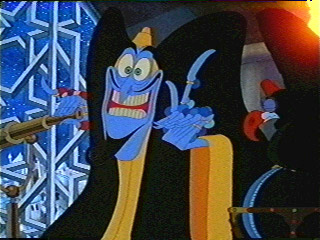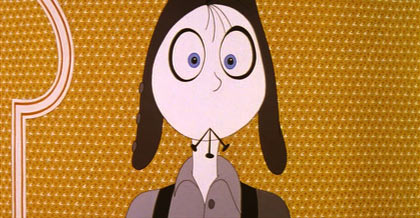 This story might be popularly known with animation fans but little to the American public. Critically acclaimed and award winning animator and director Richard Williams had been working on a movie that have taken many many names. To fans, it is most popularly known as The Thief and The Cobbler. No documentary or book has properly told this story.
This story might be popularly known with animation fans but little to the American public. Critically acclaimed and award winning animator and director Richard Williams had been working on a movie that have taken many many names. To fans, it is most popularly known as The Thief and The Cobbler. No documentary or book has properly told this story.Richard Williams began development work on it in 1964, planning to do a film about the Mulla Nasruddin, a "wise fool" of Near Eastern folklore. Williams had previously illustrated a series of books by Idries Shah, which collected the philosophical yet humorously wise tales of Nasruddin. Williams took on television and feature-film title projects in order to fund his pet project, and work on his film progressed slowly. In 1969, the International Film Guide noted that animation legend Ken Harris was now working on the project, which was now entitled The Amazing Nasruddin. The illustrations from the film showed intricate Indian and Persian designs. In 1970, the project was re-titled The Majestic Fool. For the first time, British Lion was mentioned as a potential distributor for the independent film. The Guide noted that the Williams Studio's staff had increased to forty people for the production of the feature.
 Dialogue tracks for the film referred to as Nasruddin!, were recorded in 1970. Vincent Price performed the voice of the villain, Zigzag (Once known as Anwar), originally assigned to Kenneth Williams. Sir Anthony Quayle (he also was interviewed in 1989 British documentary) was cast as King Nod. Williams was a great fan of Vincent Price's work, and Zigzag became his favorite character to animate. Unfortunately in 1972, Williams had a falling-out with the Shah family. A promotional booklet released in 1973 failed to mention that almost all of the Nasruddin footage, characters and scenes that did not have Nasruddin himself were retained. While the story's focus and tone was shifted, several characters, including Zigzag, were all carried over to the "new" film, which Williams was promising as a "100 minute Panavision animated epic feature film with a hand-drawn cast of thousands."
Dialogue tracks for the film referred to as Nasruddin!, were recorded in 1970. Vincent Price performed the voice of the villain, Zigzag (Once known as Anwar), originally assigned to Kenneth Williams. Sir Anthony Quayle (he also was interviewed in 1989 British documentary) was cast as King Nod. Williams was a great fan of Vincent Price's work, and Zigzag became his favorite character to animate. Unfortunately in 1972, Williams had a falling-out with the Shah family. A promotional booklet released in 1973 failed to mention that almost all of the Nasruddin footage, characters and scenes that did not have Nasruddin himself were retained. While the story's focus and tone was shifted, several characters, including Zigzag, were all carried over to the "new" film, which Williams was promising as a "100 minute Panavision animated epic feature film with a hand-drawn cast of thousands."Williams worked on the production in-between various TV commercial, TV special, and feature film title assignments, such as the 1977 feature Raggedy Ann & Andy: A Musical Adventure. In an interview with John Canemaker in the Feb. 1976 issue of Millimeter, Richard Williams stated that "The Thief is not following the Disney route." He went on to state that the film would be "the first animated film with a real plot that locks together like a detective story at the end," and that, with its two mute main characters, Thief was essentially "a silent movie with a lot of sound." Unfortunately, ultimately it went the 'Disney route.'
In 1986, Williams met producer Jake Eberts, who began funding the production and, according to the August 30, 1995 edition of The Los Angeles Times, eventually provided $10 million of the film's $28 million budget. In a 1988 interview with Jerry Beck, Williams stated that he had two and a half hours of pencil tests for Thief and that he hadn't storyboarded the film as he found such a method too controlling. After serving as animation director on Who Framed Roger Rabbit, Williams received funding and a distribution deal for The Thief and the Cobbler with Warner Bros. Pictures. At this point, with almost all of the original animators either dead or having long since moved on to other projects, that full-scale production on the film began, mostly with a new, younger team of animators, including Richard Williams's son Alexander.
The film was not finished by the 1991 deadline that Warner imposed upon Williams. The film was still several months and fifteen minutes of screen time away from completion. Meanwhile Disney begun work on Aladdin, a film which bore striking resemblances in tone and style to The Thief and the Cobbler; for example, the character Zigzag from Cobbler shares many physical characteristics with both Jafar, and the Genie. Also, the scene in which Abu wants to steal a ruby from the Cave of Wonders is very similar to a scene where The Thief tries to steal a gem. Williams's film had been in production so long that scenes from it had been seen or worked on by many people in the animation industry, some of whom had gone on to work at Disney.
 With that film's release and its potential competition as a threat to films commercial viability, Williams was asked to show the investors a rough copy of the film with the remaining scenes filled in with storyboards. Williams had avoided storyboards up to this point, but within two weeks he had done what the investors had asked. This rough version of the film was not well received, and on the very next day Warner backed out and the Completion Bond Company assumed control of the film from Williams's studio. Television animation producer Fred Calvert was assigned by the Completion Bond Company to finish the film as cheaply and quickly as possible. In the process, Calvert made several significant changes to the film.
With that film's release and its potential competition as a threat to films commercial viability, Williams was asked to show the investors a rough copy of the film with the remaining scenes filled in with storyboards. Williams had avoided storyboards up to this point, but within two weeks he had done what the investors had asked. This rough version of the film was not well received, and on the very next day Warner backed out and the Completion Bond Company assumed control of the film from Williams's studio. Television animation producer Fred Calvert was assigned by the Completion Bond Company to finish the film as cheaply and quickly as possible. In the process, Calvert made several significant changes to the film.Much of Williams's finished footage was deleted from the final release print to make way for newly created scenes and horrible song sequences. Steve Lively was brought in to record a voice and narration for the previously mute character of Tack and several other characters that already had vocal tracks prepared for them were re-voiced. The new scenes were produced on a budget and the quality of the art is much akin to Korean Saturday morning cartoons, with little regard for matching the painstaking quality of Williams's original scenes. However, some audio from the original version were retained, like Sir Anthony Quayle's voice can still be heard in the speech scene.
Calvert's version of the film was distributed outside of the United States as The Princess and the Cobbler; in the U.S., the Disney subsidiary Miramax released their own version, Arabian Knight, in which the film was recut even further. The voices of Matthew Broderick and Jonathan Winters were added over nearly every scene of the film; Williams' version had been largely dialogue-less. The character of the Old Witch was entirely removed (save for a few lines of dialogue and ghost-like image), as was most of a climactic battle sequence. Arabian Knight was quietly released by Miramax on August 25, 1995. It opened on 510 screens, and grossed just over $300,000 (on an estimated budget of $24 million) during its theatrical run. To this day, the film has never been released, in any form, in the United Kingdom.
Titles the film has gone through:
The Amazing Nasruddin
The Majestic Fool
Nasruddin!
The Thief Who Never Gave Up and Once
The Thief and the Cobbler
The Princess and the Cobbler (World, except U.K. 1994)
Arabian Knight (U.S. 1995)
The Miramax version Arabian Knight was first released commercially on DVD on March 8, 2005, in pan-and-scan format. This DVD was re-released by The Weinstein Company on November 21, 2006. It was renamed The Thief and the Cobbler, even though it has Matthew Broderick's voiceover the originally mute Tack and the crappy singing sequences. Here is the trailer for that:
A fan-made restoration with various special features such as commentaries was released on DVD in August 2006, and this version has been tacitly acknowledged by several DVD reviewers to be better than the latest officially-released DVD.
In the late 90's, Roy Disney began a project to restore The Thief and the Cobbler to as close to Williams' original intent as possible. He sought out original pencil tests and completed footage, much of which was by this time in the possession of various animators and film collectors. Roy Disney left the Walt Disney Company in 2003, and the restoration project was put on hold. Negotiations between Disney and Williams broke down when it was revealed that Williams wouldn't be paid because of budget problems, even though he would be promised a release of the result. Currently, Disney producer Don Hahn is considering reviving the project.